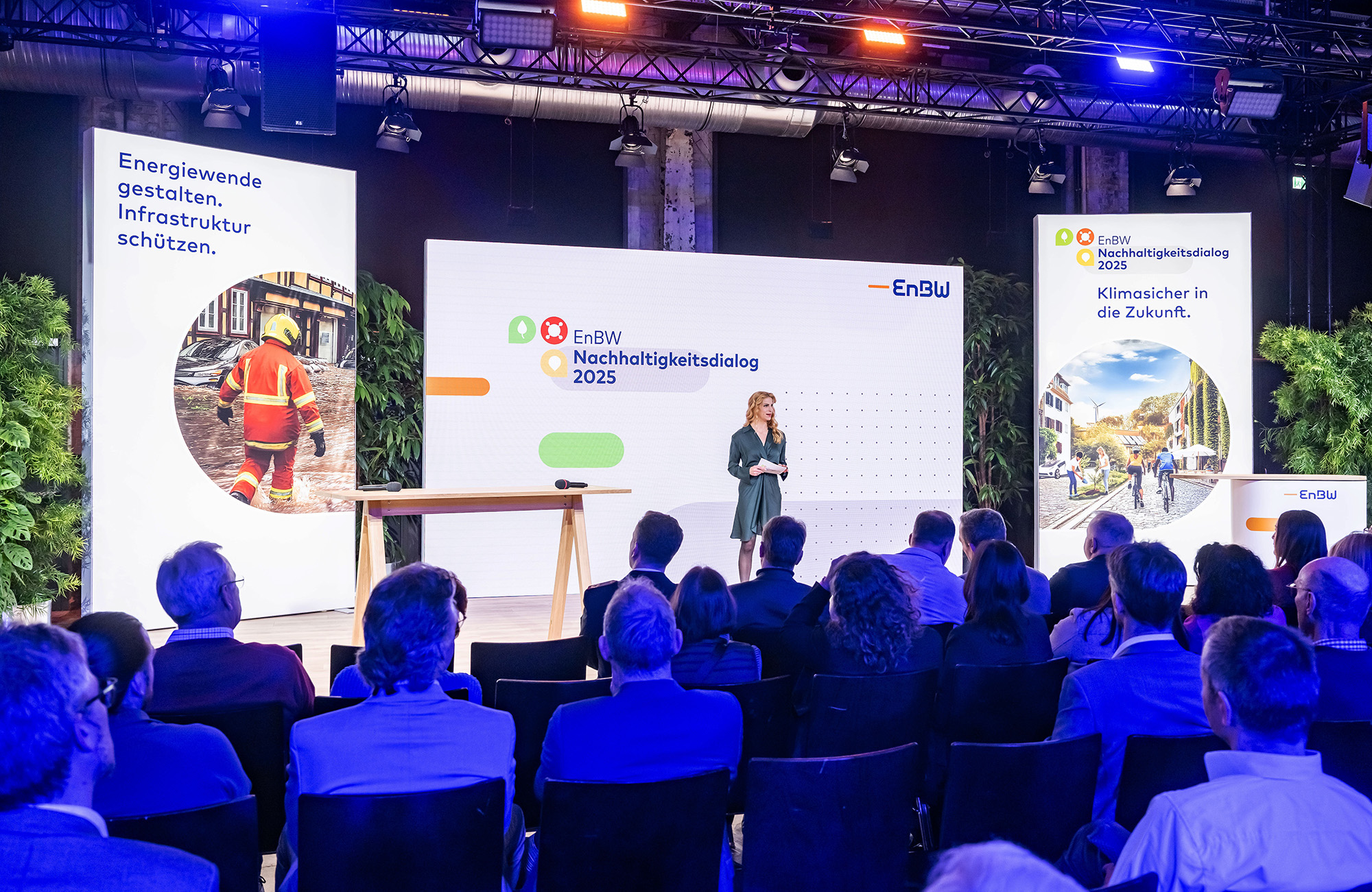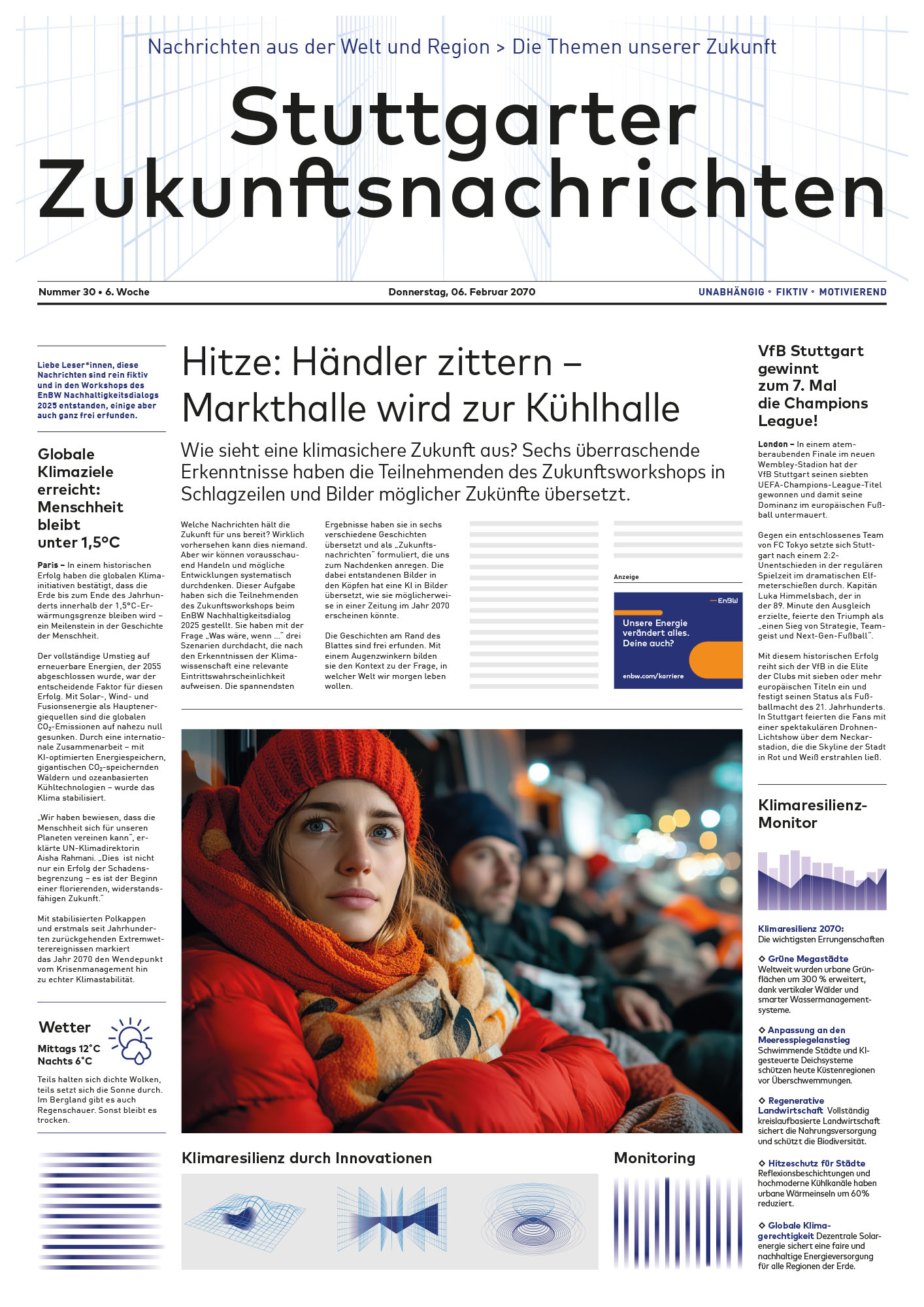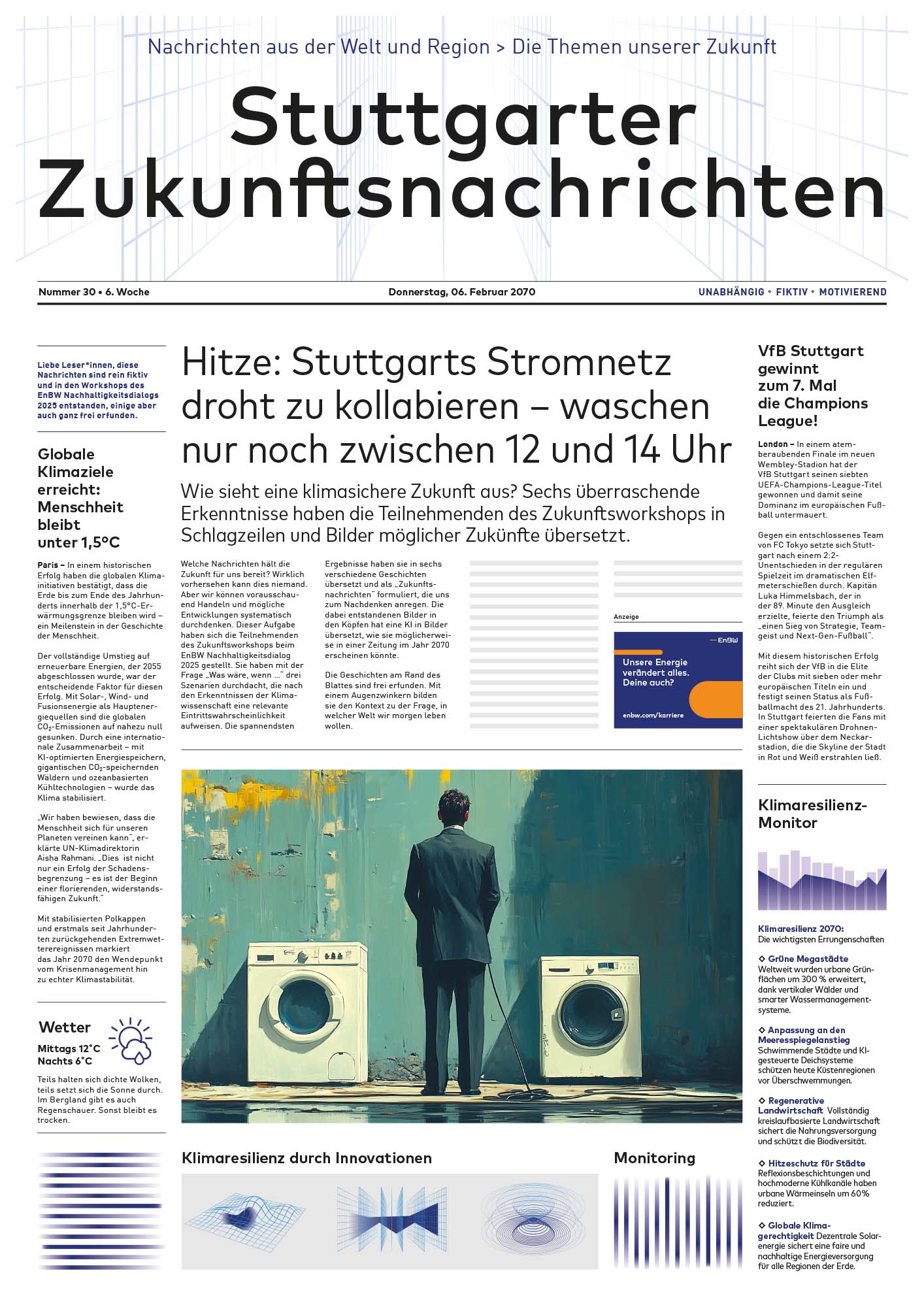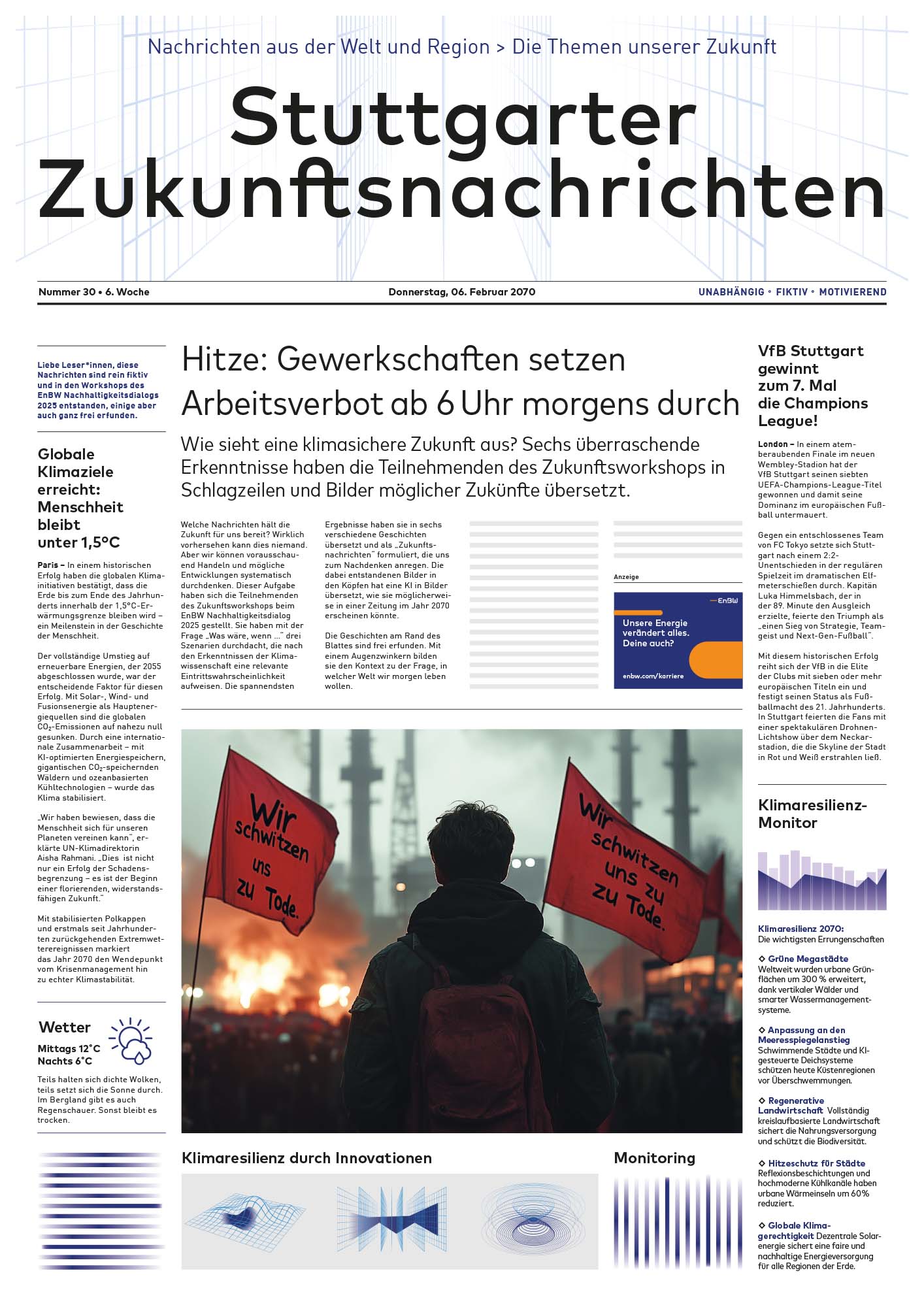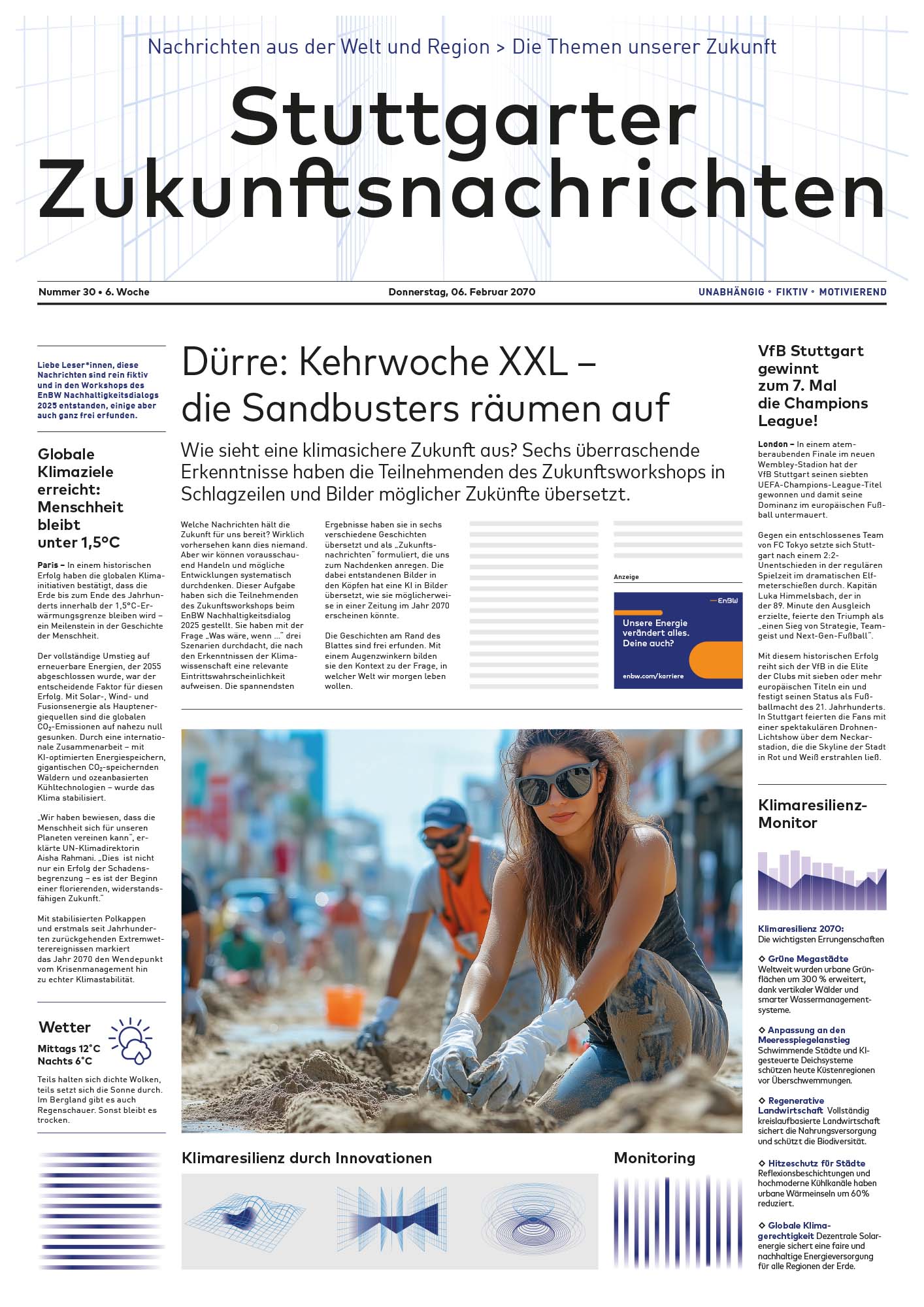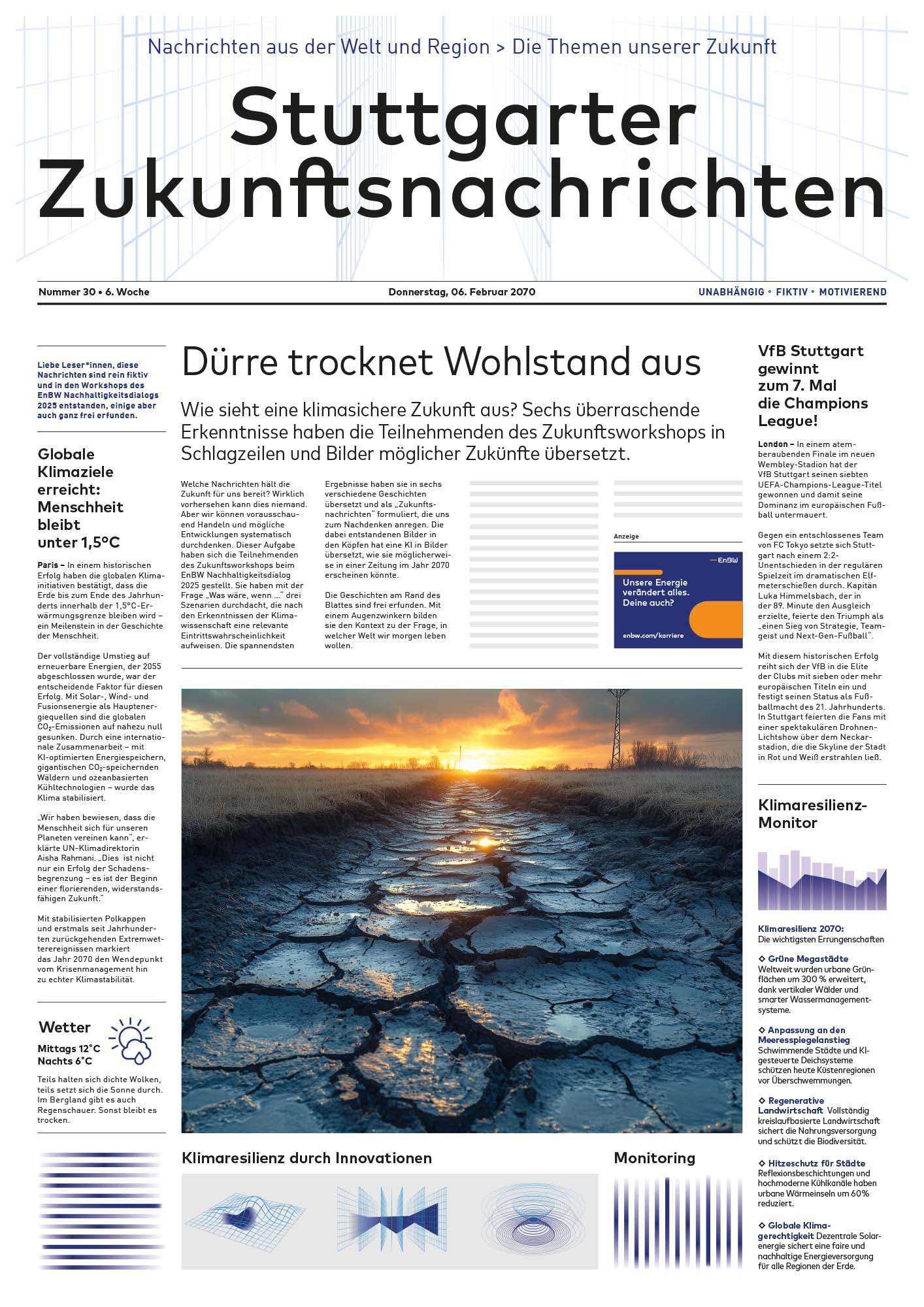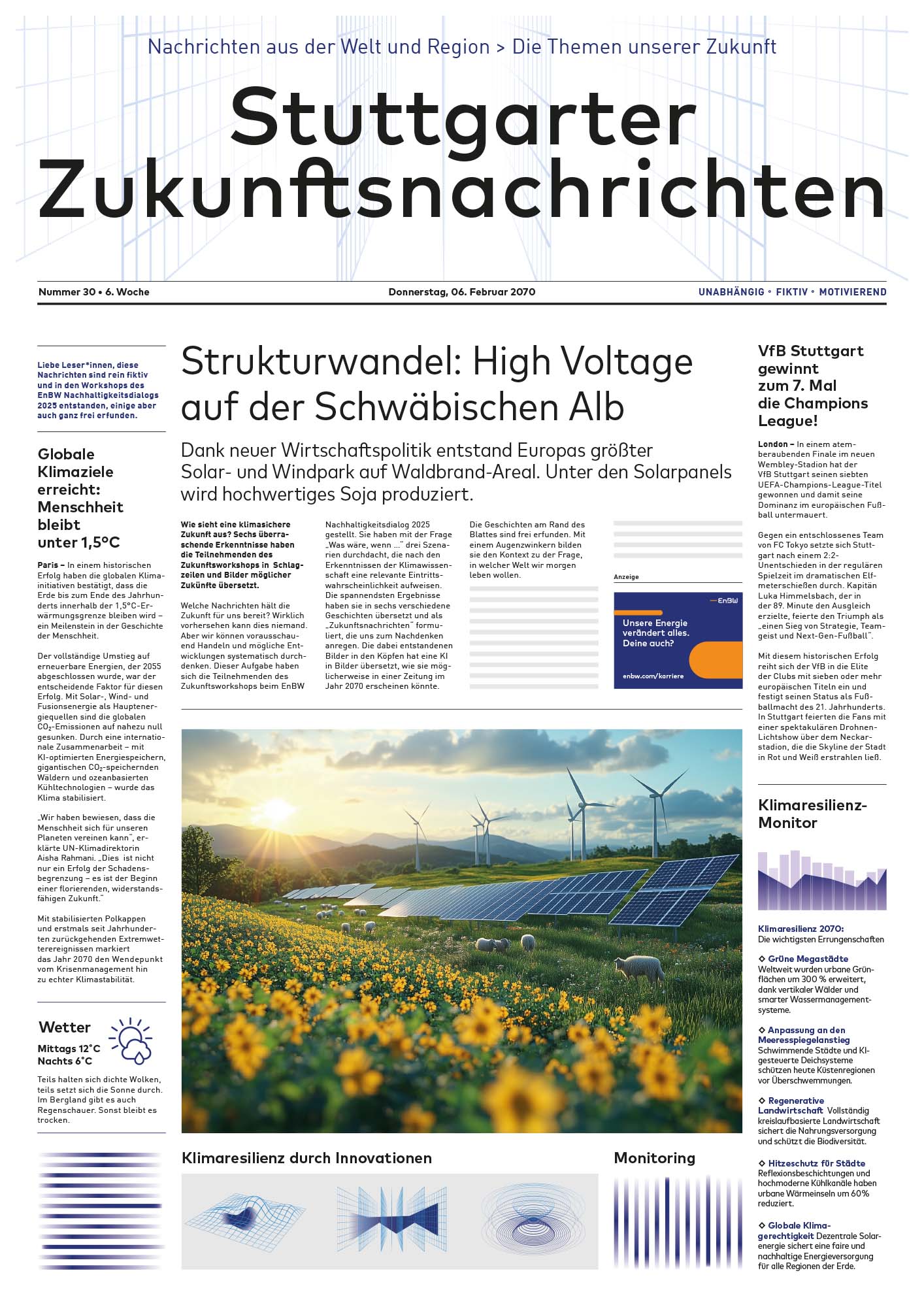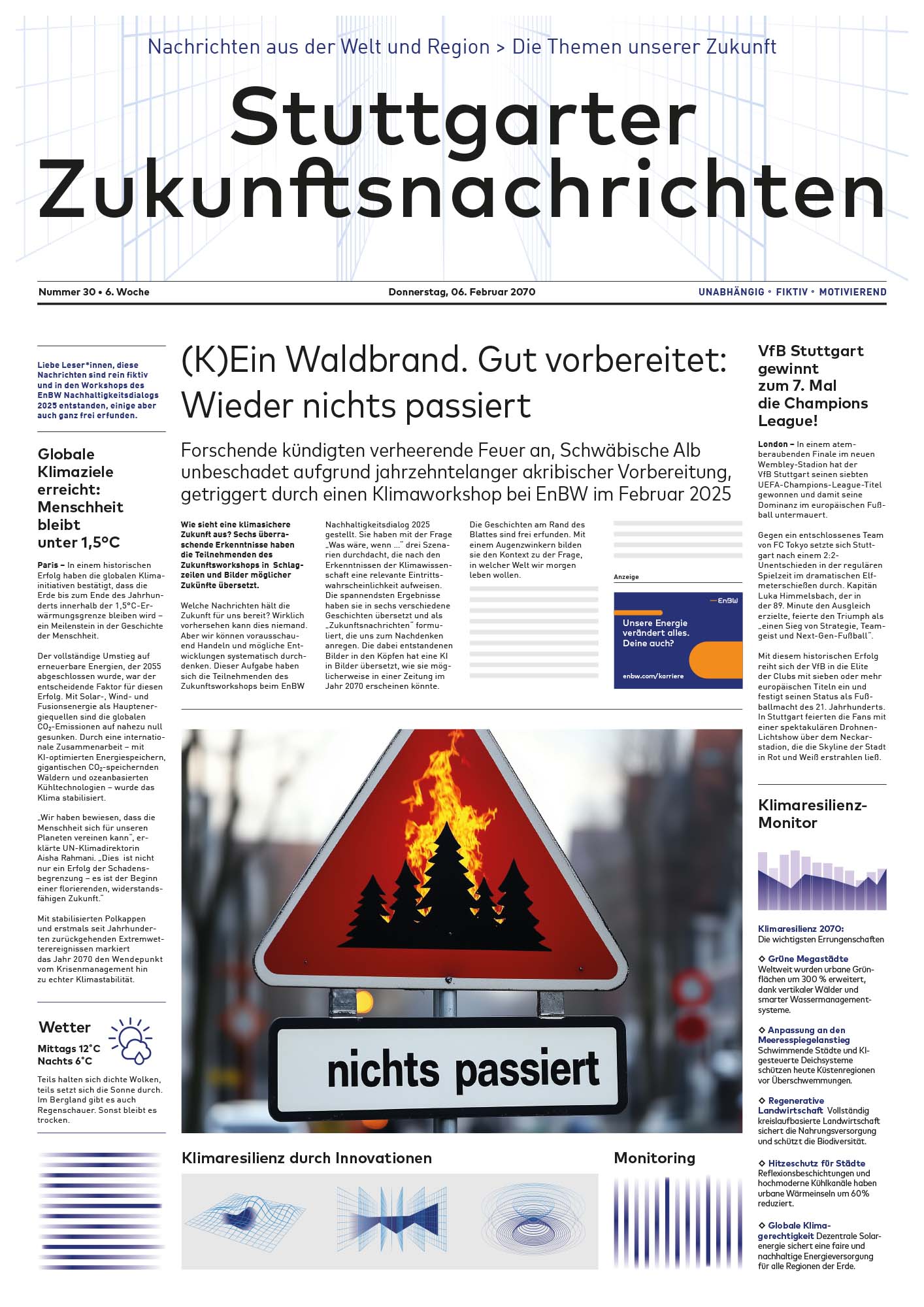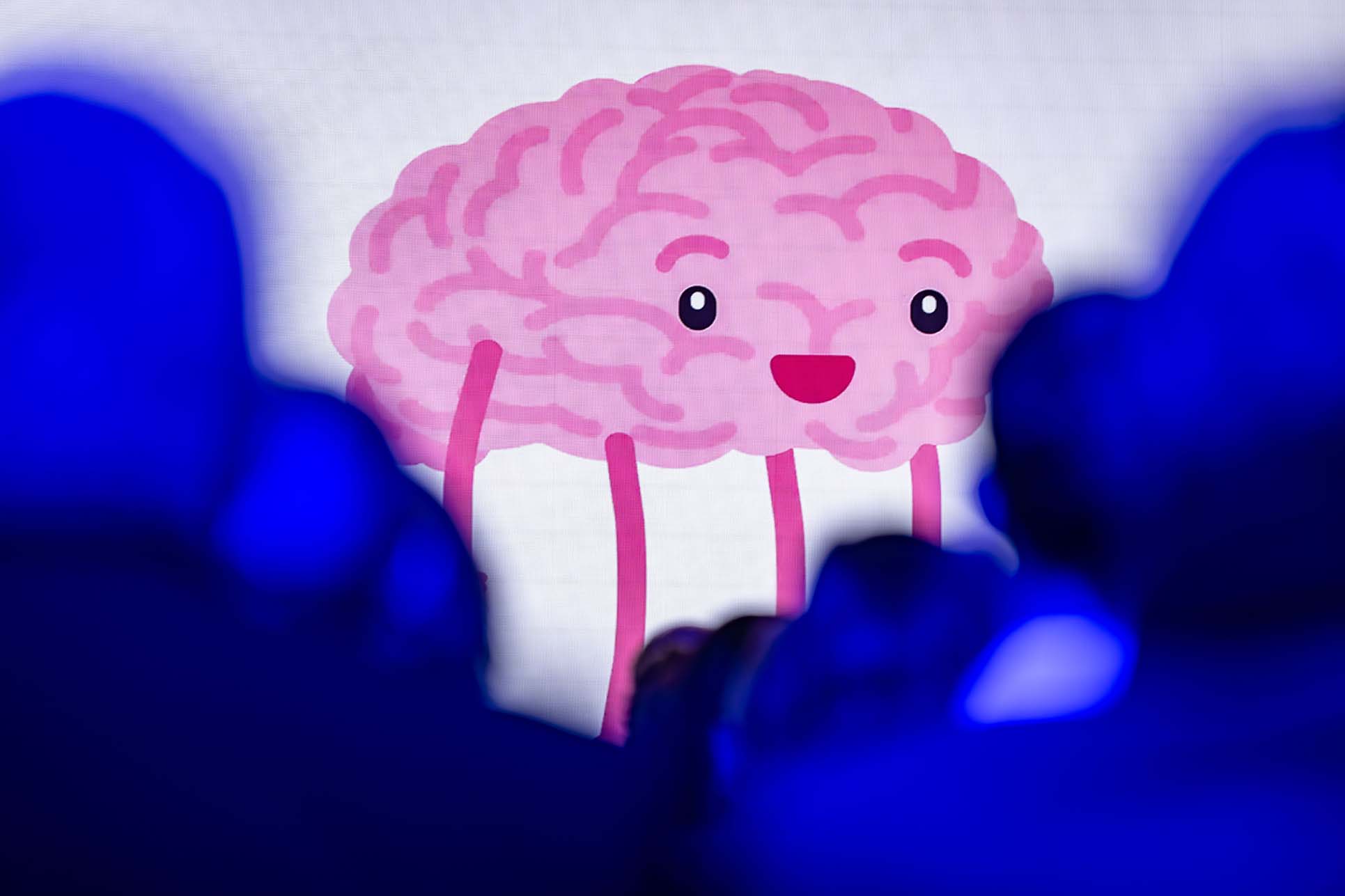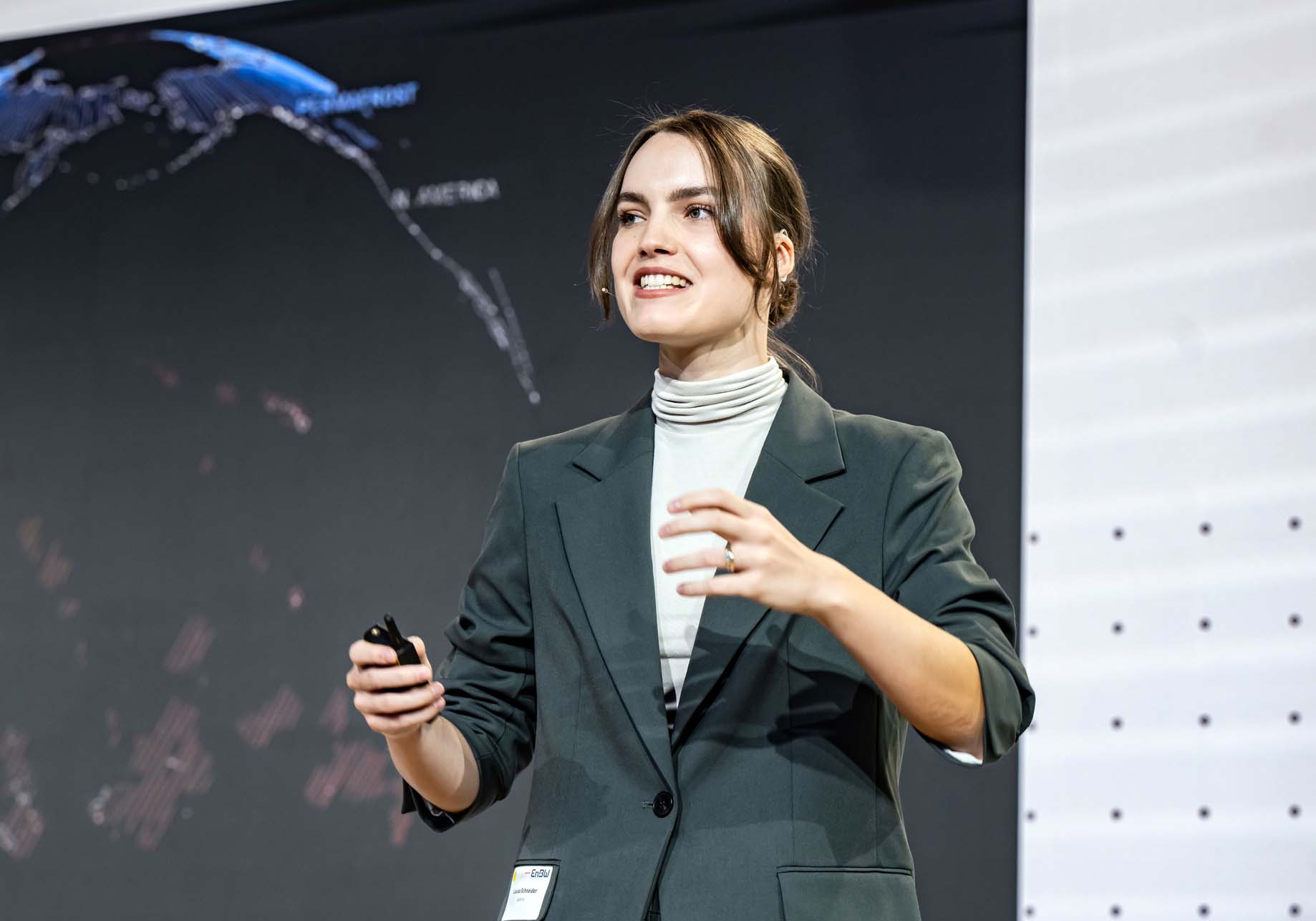Heat, heavy rain and flooding – extreme weather events are also increasing in Baden-Württemberg. At the EnBW Sustainability Dialogue 2025, experts from politics, business, science and civil society discussed how municipalities can adapt even better to the effects of climate change.
The sustainability dialogue provided a platform for the interaction of all actors involved and provided inspiring impulses for the design of a climate-proof future. Coool supported the high-profile event in communication, format development and implementation of a demanding workshop program.
Narrative
Communication concept
Format development of the event
Workshop development and facilitation
Experience design
Event landing page
Event direction
In a nutshell:
3-minute recap
Our task: Three interlocking components
1
Narrative and communication
The essential basis of the event was a clear positioning: With which claim and which call-to-action does EnBW invite its stakeholders to a dialog? How can we condense the agenda into a concise formula and convey it with a clear framing?
2
Format development
.How do we bring the participants into a genuine, value-creating dialog with each other that will deliver on the set agenda? How do we create space for relevant discourse?
What methodology leads people to open up, work together and learn from each other?
3
Facilitation and process control
The implementation of the meticulously planned, dramaturgically interlinked parts of the event: Well-thought-out large group workshops around relevant future issues for a limited number of participants and an evening event with exciting impulses and an in-depth panel discussion.
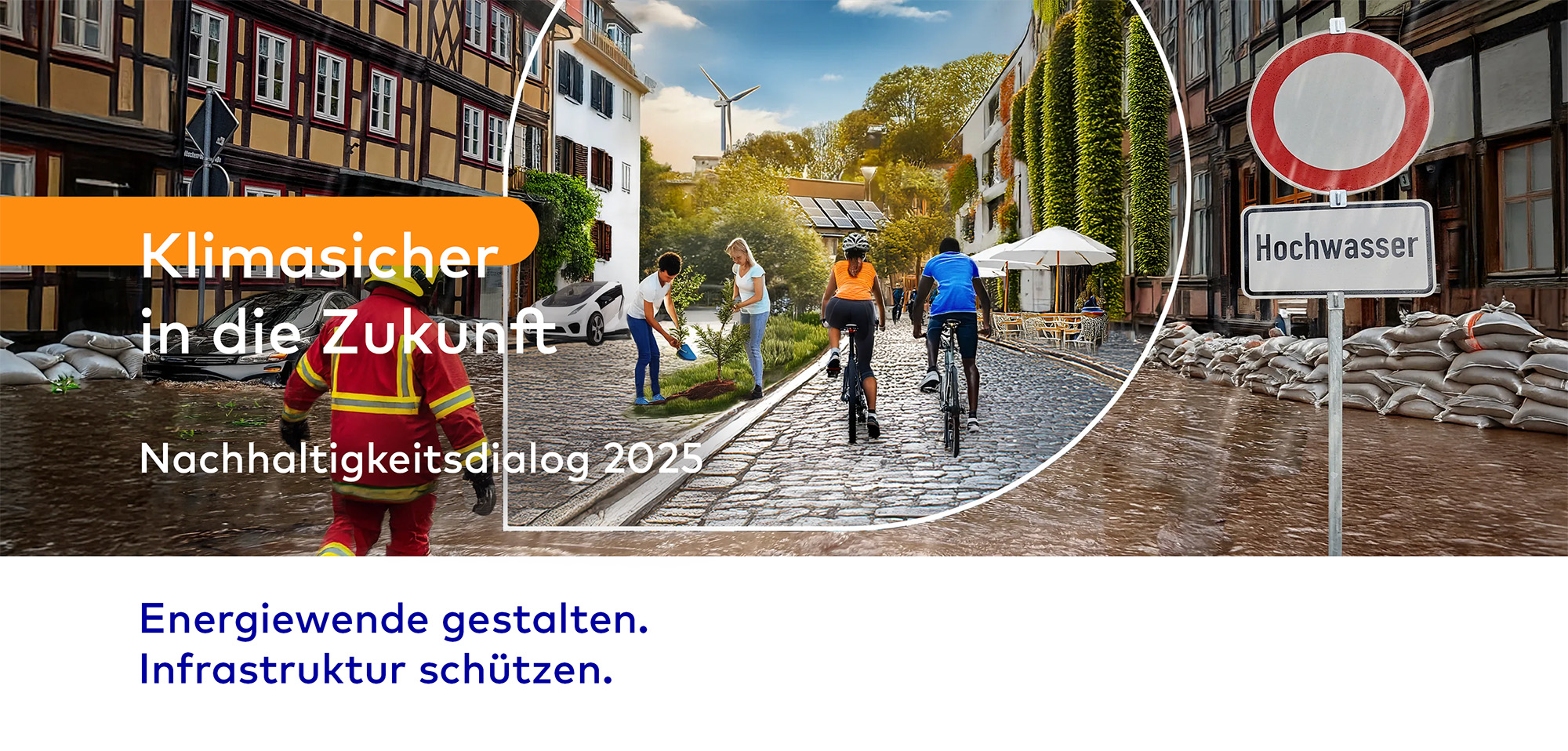
Narrative and framing
Climate resilience – what does this actually mean? How do we deal with the risks we face as a result of the climate crisis?
Climate resilience is a task for society as a whole. It covers the entire spectrum from climate protection to climate impact adaptation. It is an issue that particularly affects local authorities, but cannot be solved by them alone. Adaptation measures need to be developed and financed. It is therefore high time to expand resilient partnerships, develop solutions together and discuss implementation conditions.
The answer of EnBW
As the only fully integrated energy group in Germany, EnBW focuses on the long-term supply of energy. Thanks to its positioning, it offers perspectives, expertise and solutions ranging from a decarbonized energy supply to robust infrastructures.
Climate-proofing the future therefore means shaping the Energy transition and protecting infrastructure. Together with local government, politics, civil protection, business, science and civil society.
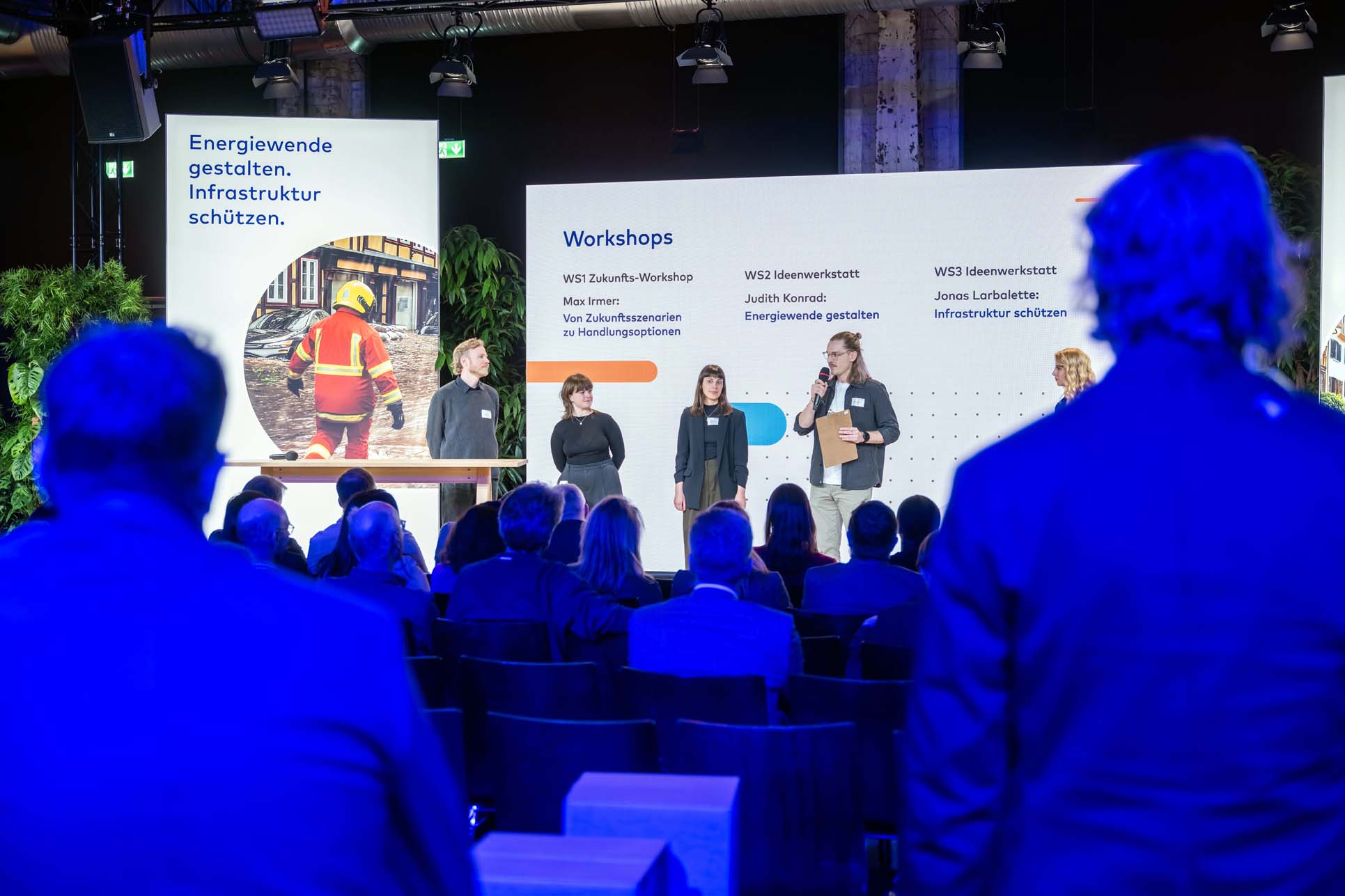
A dialog which can call itself that
Of the more than 300 participants, over 100 took part in the three workshops with a limited number of participants in the afternoon. The main aim of the workshops was first and foremost to get the various stakeholder groups talking and exchanging experiences. The second goal was to jointly develop results that address the participants’ biggest pain points and thus provide them with practical suggestions..
Create relevance
In order to identify these pain points and develop relevant working questions, workshops were held in advance with representatives of the stakeholder groups and technical experts and a suitable workshop method was developed. The workshops began with an introduction by an expert from EnBW and an impulse from an external specialist speaker.
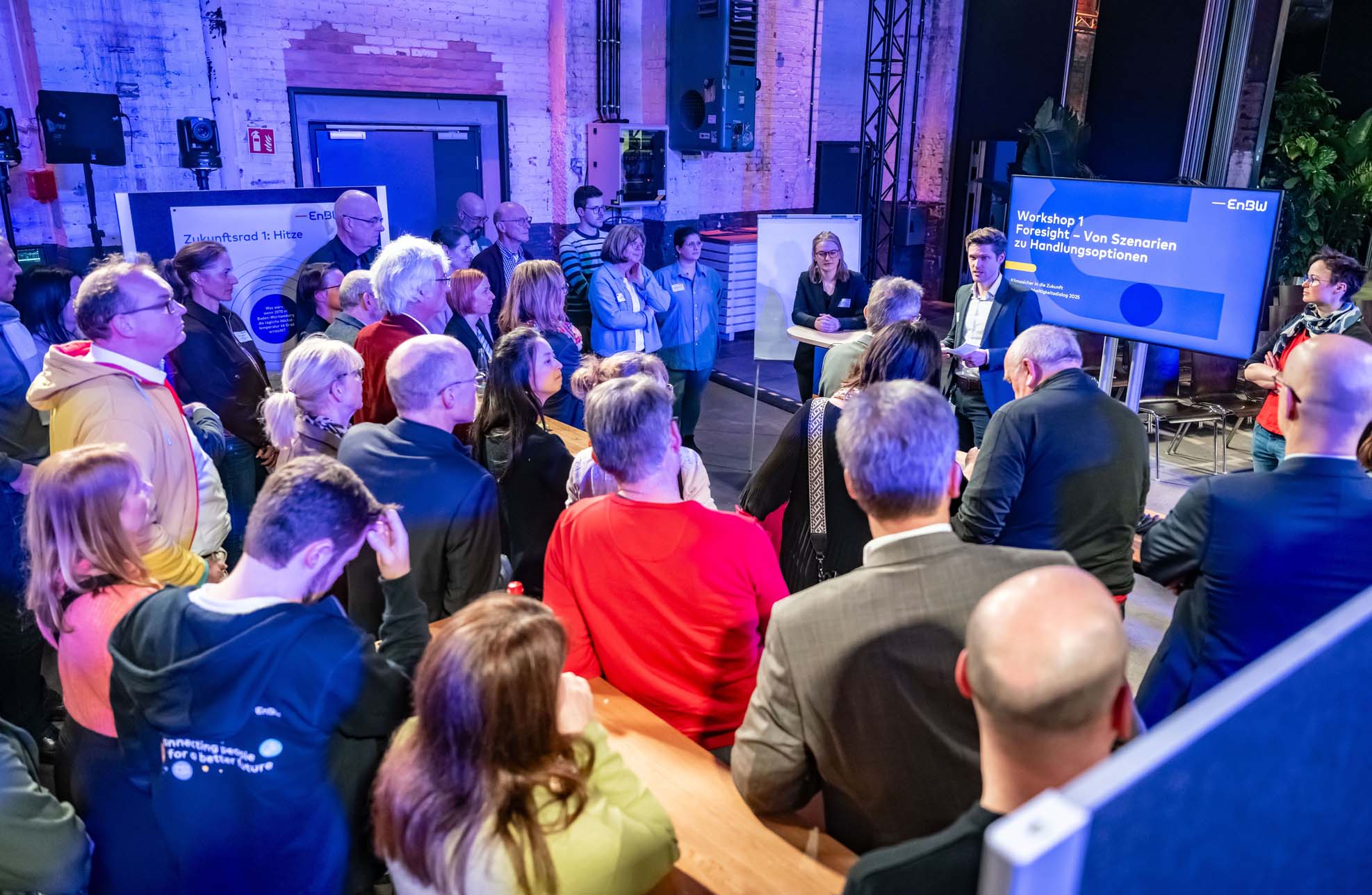
Foresight workshop: From future scenarios to options for action
Foresight expert Max Irmer from the coool team led seven small groups in systematically thinking through future scenarios based on three key questions using the FutureWheels methodology:
What if … the maximum daily temperature in Baden-Württemberg reaches 46 degrees in 2070?
If it does not rain in Baden-Württemberg for more than two months in 2070?
If there is a huge, uncontrollable forest fire in the Swabian Alb in 2070?

Taming the big white elephant
In addition to the surprising results, the aim of the workshop was to learn how to tackle an insurmountable, overly large and threatening future issue in the first place, thereby removing its paralyzing magnitude.
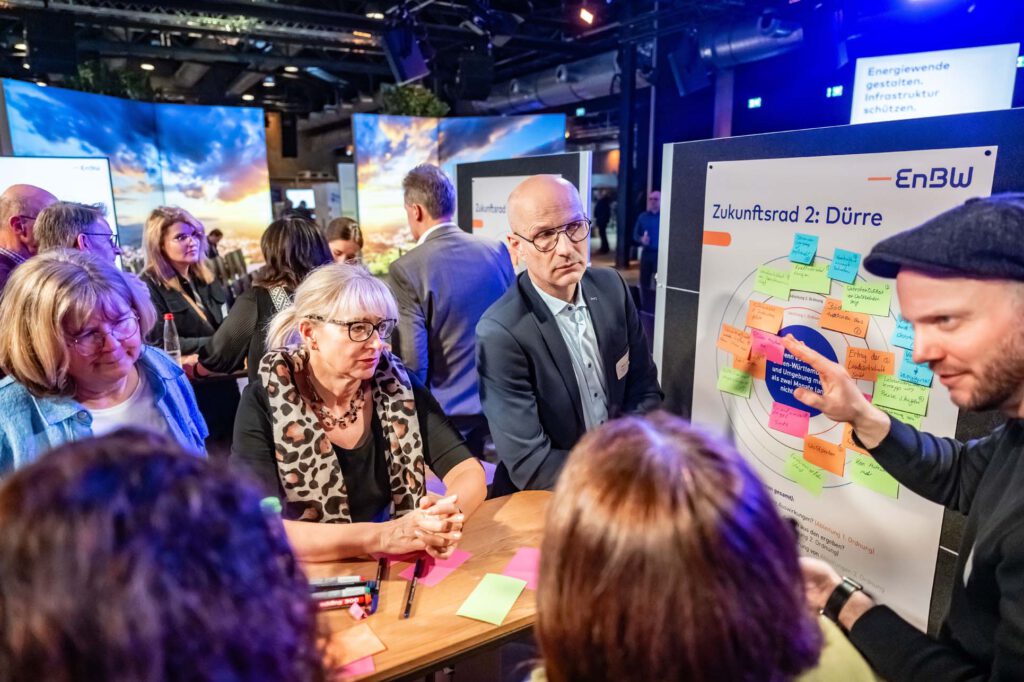
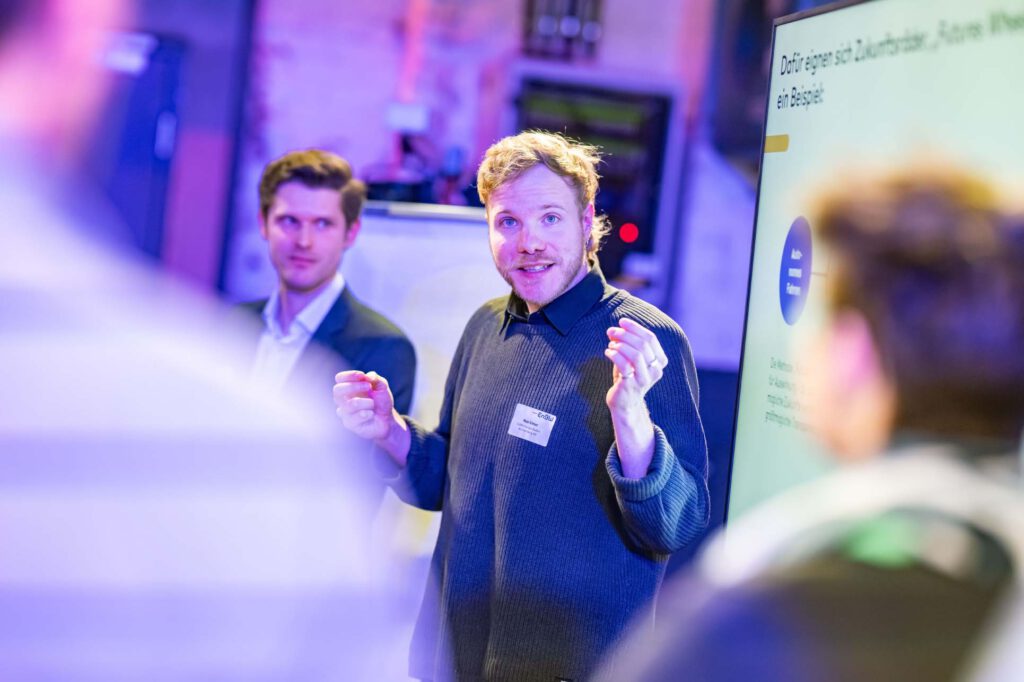
Another insight gained by the committed participants was to resolve the so-called cooperation dilemma. This describes the situation where the impact of a person’s or organization’s actions is too far away in terms of time or space, resulting in a loss of immediacy. Here, things suddenly became tangible again!

Dr. Jan Eichstädt (Sustainability and Climate Risks, EnBW) and Elisa Seith (Climate Risks and Resilience, Jupiter Intelligence) provided exciting insights into the systematic and scientific assessment of climate risks.
Making the future tangible:
The future news
As the final step of the workshop, the participants formulated the most exciting insight in the form of a fictitious “future news item”, a newspaper headline, as it might appear in the year 2070. They then sketched or described a picture motif.
The coool team transformed the image motifs into fictitious images directly on site using generative AI, placed the headlines in a specially designed newspaper layout and distributed over 300 copies of the future news at the event. The remaining stories in the newspapers were fictitious – stories of success and hope (at least in relation to VfB!).
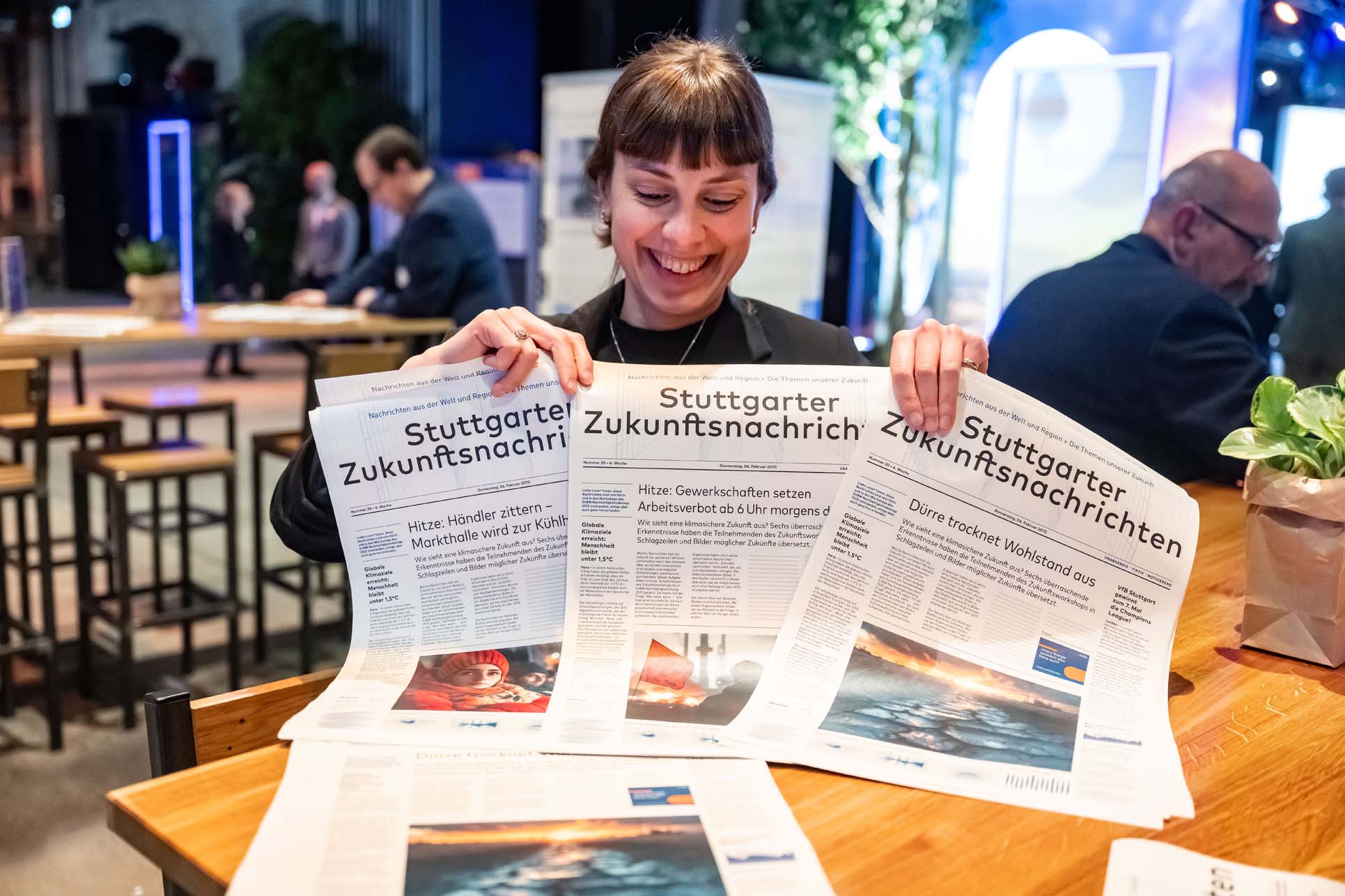
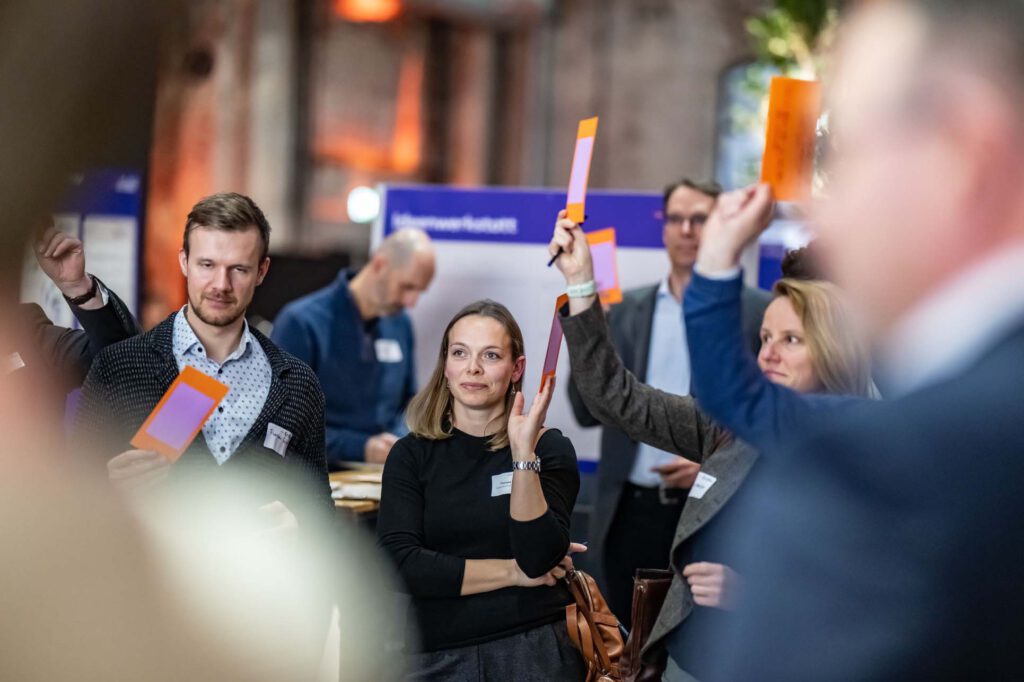
The ideas workshops
Learning from each other and developing solutions together: Two highly topical issues for local authorities were the focus of the two workshops, which were designed and moderated by the workshop facilitators from the coool team Jonas Larbalette and Judith Konrad.
Shaping the energy transition
How can we bring together the existing expertise and players to implement the municipal heating transition in a timely manner?
Protect infrastructures
Wie könnten wir Präventionsmaßnahmen so kommunizieren, dass sie im Handeln der Kommunen und in der How can we communicate prevention measures in such a way that they are given the right status in the actions of local authorities and in urban society and can therefore be implemented? den richtigen Stellenwert haben und damit umsetzbar werden?
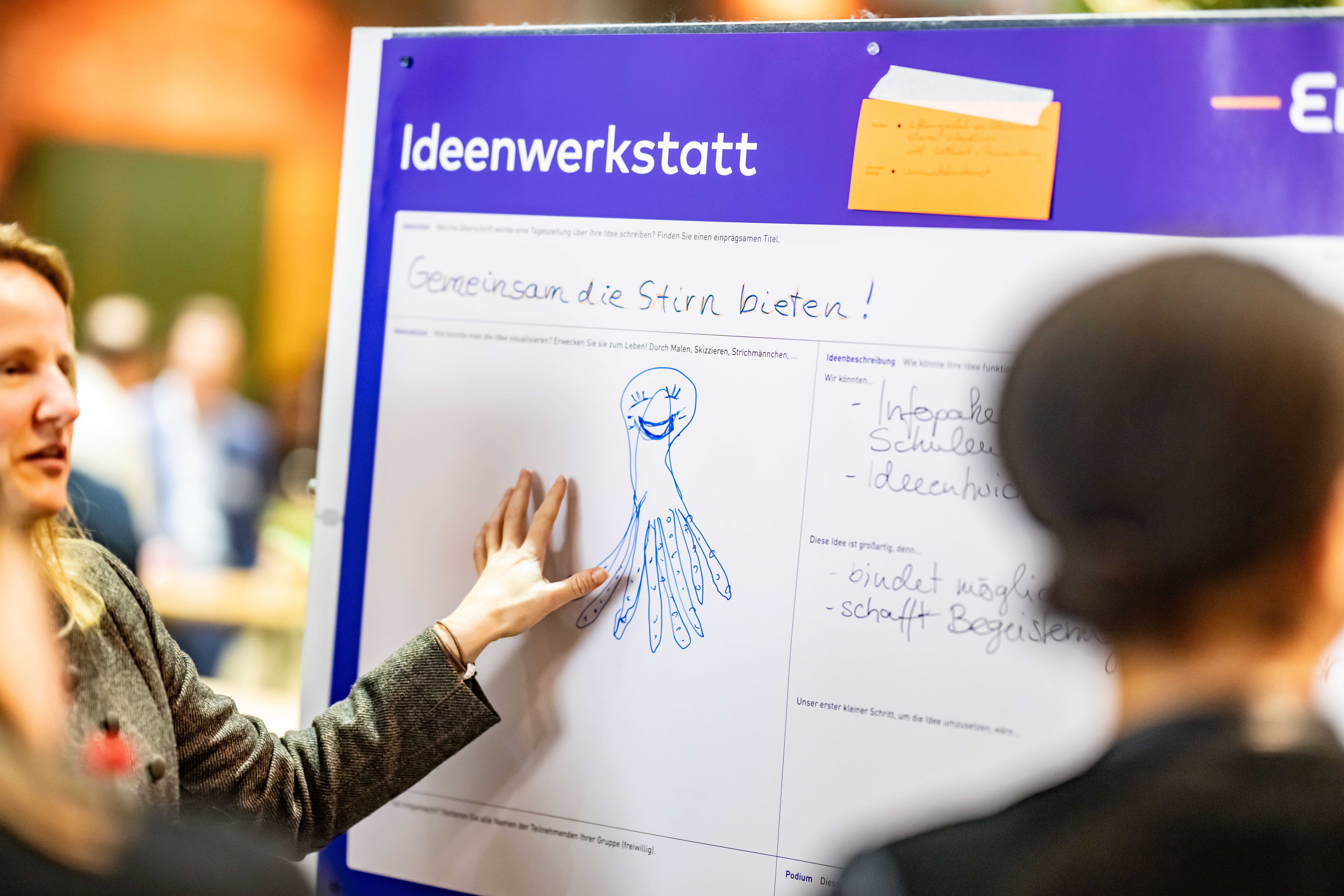
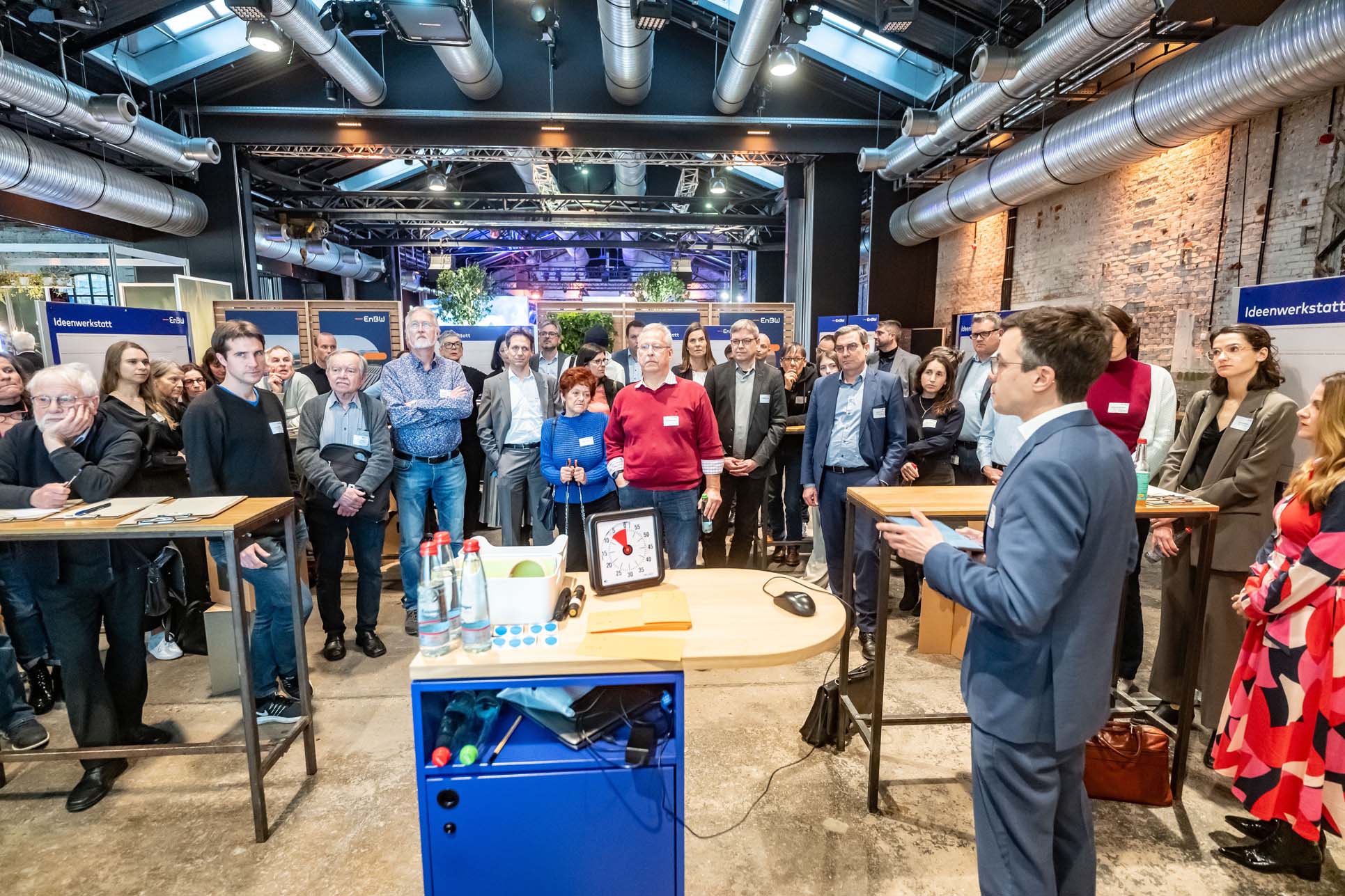
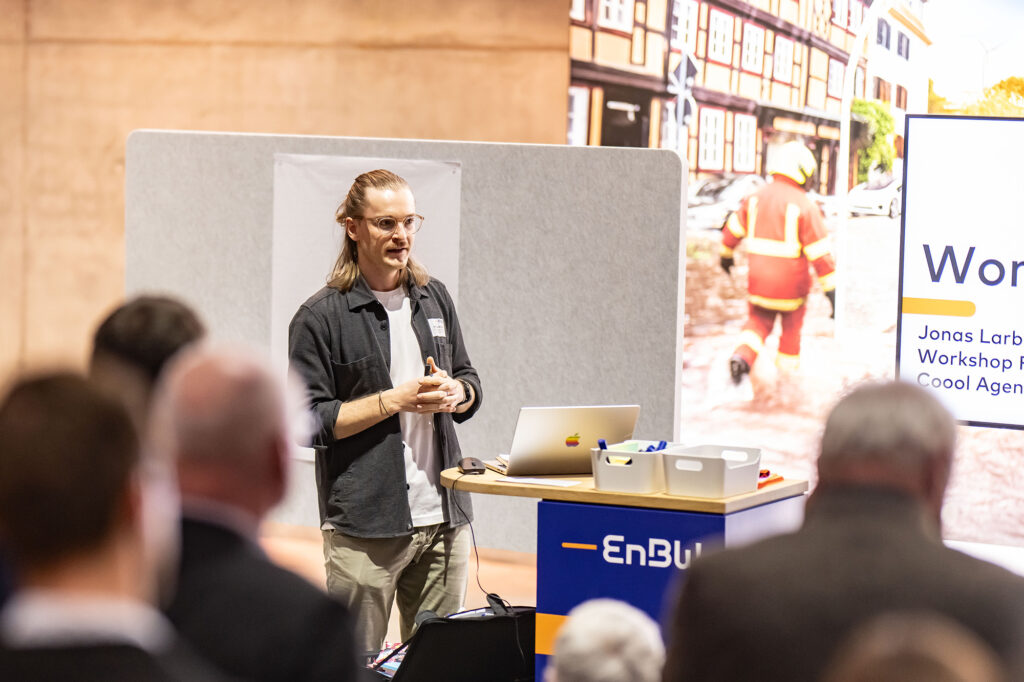
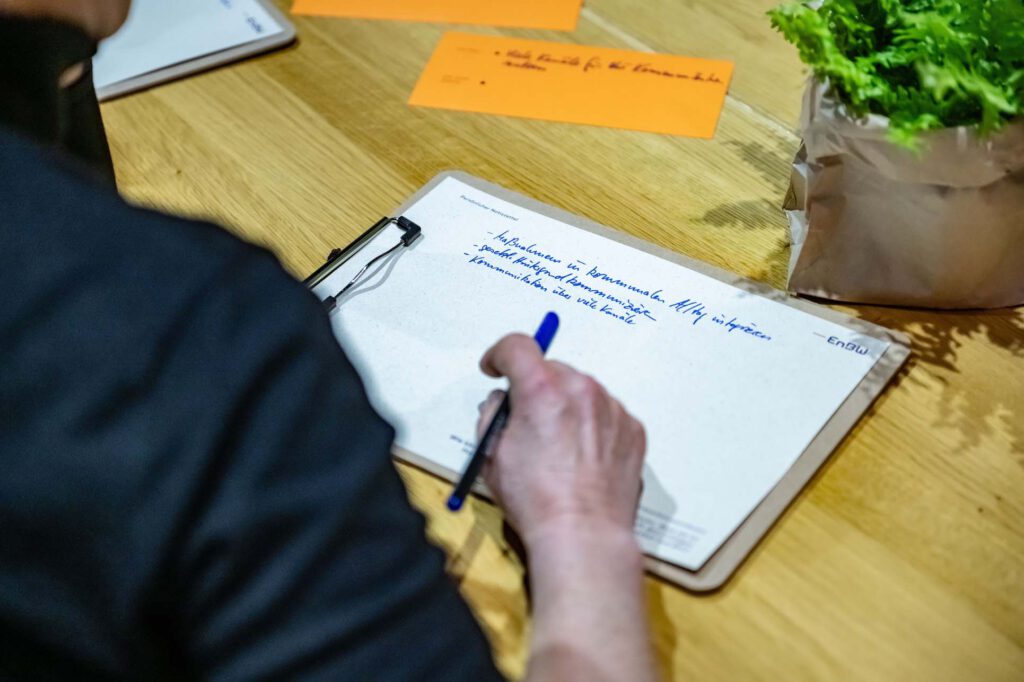
The event was introduced by Stefanie Jelinek and Janina Szemkus (EnBW), with input from Dominik Bernauer (Baden-Württemberg Ministry of the Environment) and Meri Eremut (heavy rainfall manager).
The participants worked with the 25/10 crowdsourcing method to generate many ideas that could be implemented quickly and easily, and to curate and refine the best ones.
Impulse and discourse
The evening event kicked off with three very different focal points: In addition to an emotional journey to the Earth’s climate tipping points with journalist and activist Louisa Schneider, a look at climate risks from the perspective of the insurance industry, neuroscientist Prof. Dr. Maren Urner showed us that, despite all our rationality, we as humans are quite emotion-driven beings. Two insights that are essential for us as communicators, firstly: according to Urner, humans have primarily benefited from acting cooperatively throughout their long evolutionary history. Secondly, they are storytellers. We need to tell new stories. Stories of success. She concludes with the question:
What stories will we have told?
MAREN URNER
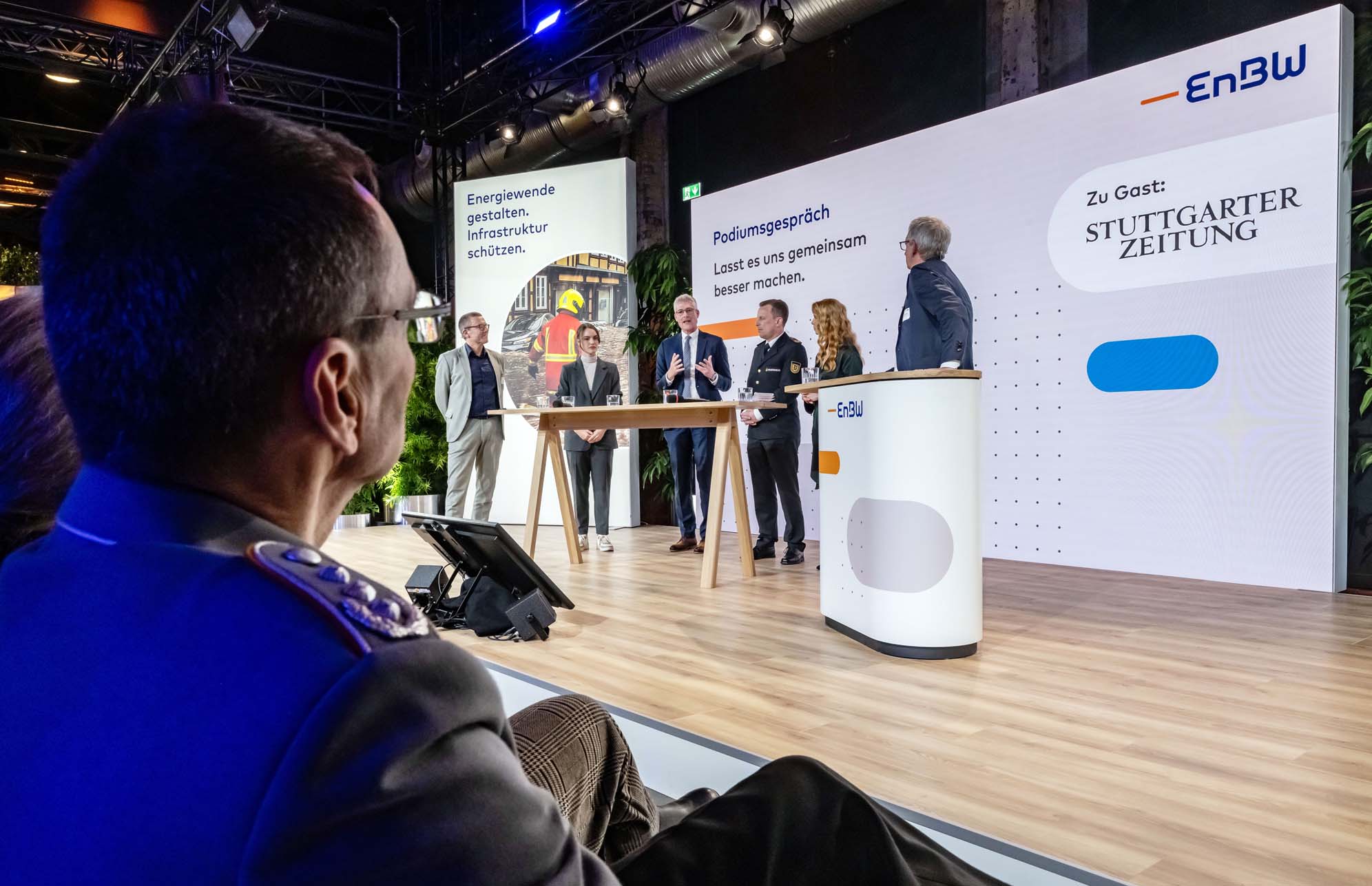
An intensive panel discussion concluded the event and offered participants the opportunity to talk to the experts.
This is how EnBW summarizes the findings from the event:
- Affordability remains a key element in the transformation of the energy system
- Digital heavy rain hazard maps help municipalities take effective precautions
- Even simple climate protection measures promote social acceptance
- The feeling of self-efficacy motivates people to take action against climate change
- All social actors must work together for climate resilience
The event to watch
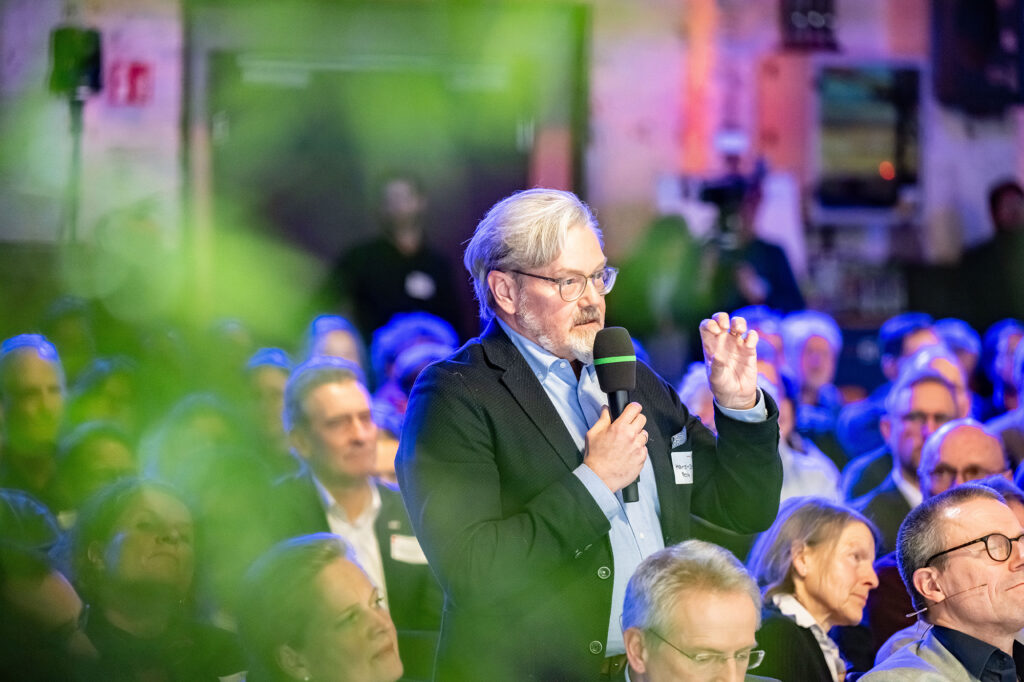
Gallery-Walk
The content was accompanied by numerous themed stands with solutions from the EnBW Group, useful tools such as flood hazard maps and a flood knowledge quiz. Participants at the evening event were able to follow the workshops through a gallery walk with the results.
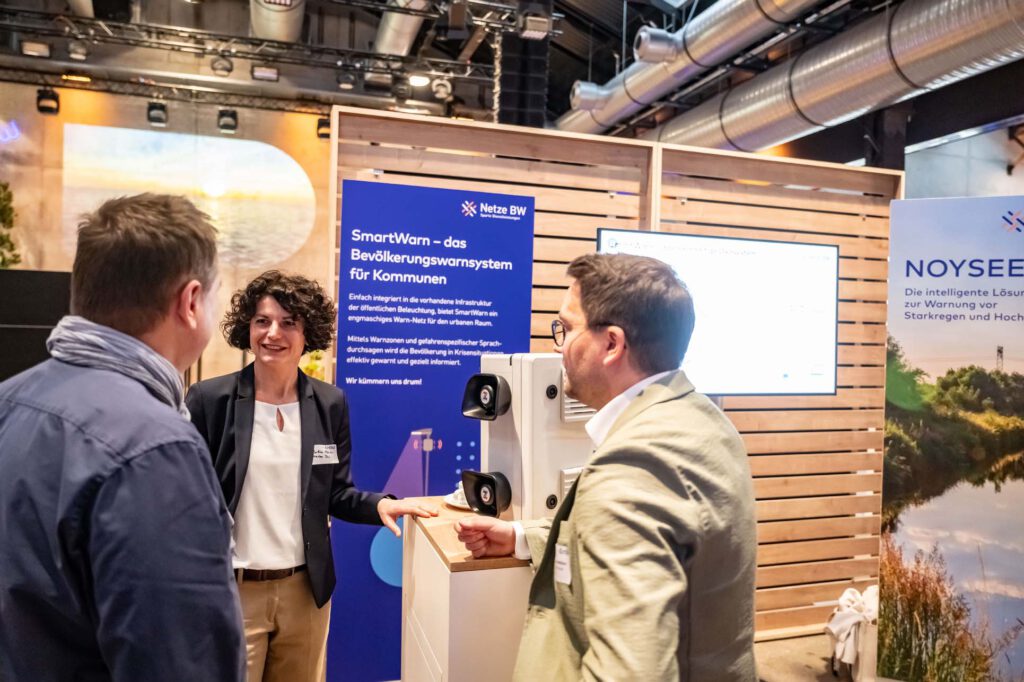
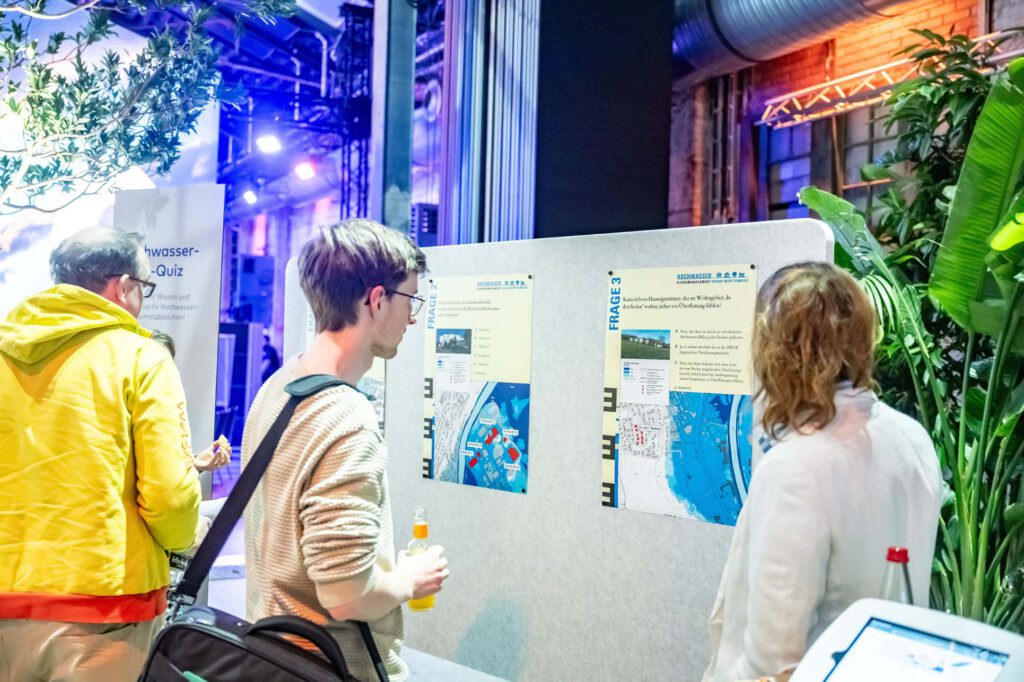

All photos: EnBW, source: ARTIS-Uli Deck
